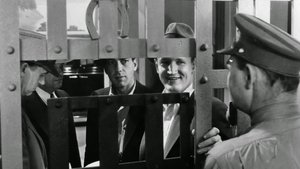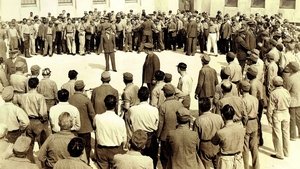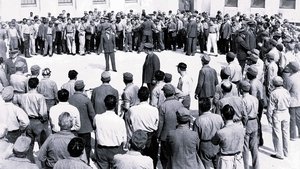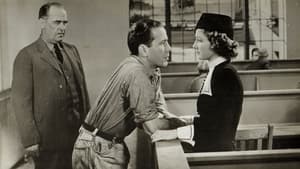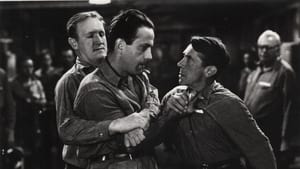Contact: info@alwanfilm.com
Video Sources 0 Views
- Watch trailer
- San Quentin


Synopsis
Table of Contents
ToggleReview: San Quentin 1937 Colorized – A Gritty Tale of Redemption and Justice

Introduction
“San Quentin” (1937) emerges as a riveting exploration of the human condition amidst the harsh realities of prison life. In this review, we delve into the significance of this early crime drama, examining its portrayal of justice, redemption, and the indomitable spirit of the human soul.
Check The Full Colorized Movies List
Check Our Colorized Movies Trailer Channel
Understanding San Quentin 1937 Colorized: Director, Cast, and Genre
Directed by the talented Lloyd Bacon, “San Quentin” (1937) showcases his adeptness in crafting compelling narratives that resonate with audiences. The film boasts an impressive cast, with seasoned actors like Pat O’Brien and Humphrey Bogart delivering powerful performances that captivate viewers from start to finish. Situated firmly within the crime drama genre, “San Quentin” (1937) offers a gritty and realistic portrayal of life behind bars, exploring themes of morality, corruption, and the pursuit of justice in a world devoid of mercy.
Exploring the World of San Quentin 1937 Colorized: Plot and Characters
“At its core, “San Quentin” (1937) follows the journey of a prison warden, portrayed by Pat O’Brien, as he grapples with the challenges of maintaining order and upholding justice within the walls of San Quentin. Alongside him, Humphrey Bogart delivers a standout performance as a hardened convict whose path intersects with that of the warden, leading to a confrontation that will test their principles and redefine their understanding of right and wrong. Through its richly drawn characters and gripping storyline, “San Quentin” (1937) offers viewers a visceral and uncompromising glimpse into the harsh realities of prison life and the human capacity for both cruelty and compassion.
The Art of Film Colorization
While “San Quentin” (1937) was originally filmed in black and white, the decision to release it in a colorized format offers audiences a fresh perspective on the timeless tale of justice and redemption. By infusing the film with vibrant hues and lifelike textures, colorization enhances the visual experience and immerses viewers in the gritty world of San Quentin, bringing its characters and settings to vivid life.
Early Colored Films: A Brief History
The history of colored films traces its origins back to the early days of cinema, with filmmakers experimenting with various techniques to add color to their creations. From hand-painted frames to early Technicolor processes, the evolution of colored film has been marked by innovation and experimentation, paving the way for the development of modern colorization techniques that continue to captivate audiences to this day.
San Quentin 1937 and Its Early Colored Version
The decision to release “San Quentin” (1937) in a colorized format offers audiences a fresh perspective on the timeless tale of justice and redemption. While some purists may balk at the idea of tampering with a classic film, colorization serves to enhance the visual experience and breathe new life into the story, allowing viewers to immerse themselves in the richly textured world of San Quentin as never before.
The Debate Over Film Colorization
The debate over film colorization remains a contentious issue in the world of cinema, with proponents arguing that it breathes new life into classic movies and introduces them to a new generation of viewers, while detractors maintain that it compromises the artistic integrity of the original work and diminishes its historical significance. As the debate rages on, filmmakers and audiences alike are left to ponder the merits and drawbacks of colorization in the ever-evolving landscape of cinema.
Examining San Quentin 1937 as an Early Colored Film
As with any colorized classic, the impact of colorization on “San Quentin” (1937) is a matter of personal interpretation. While some may argue that it enhances the film’s visual appeal and immerses viewers in its world, others may feel that it detracts from the stark beauty of the original black and white version. Regardless of one’s stance on the issue, there’s no denying the enduring power of “San Quentin” (1937) as a gripping crime drama that continues to resonate with audiences of all ages.
Influence and Legacy: San Quentin 1937 Colorized’s Impact on Cinema
“San Quentin” (1937) has left an indelible mark on the world of cinema, inspiring countless filmmakers and captivating audiences with its timeless tale of justice and redemption. From its unforgettable performances to its gritty portrayal of prison life, the film continues to resonate with viewers around the world, reaffirming its status as a true classic of the crime drama genre.
Director’s Cinematic Legacy: Beyond San Quentin 1937 Colorized
Lloyd Bacon’s influence extends far beyond “San Quentin” (1937), with a diverse body of work that continues to captivate audiences around the globe. From “42nd Street” to “Footlight Parade,” Bacon’s films are celebrated for their dynamic storytelling, memorable characters, and groundbreaking visuals, solidifying his legacy as one of the preeminent directors of Hollywood’s Golden Age. Through his groundbreaking work, Bacon has left an indelible imprint on the world of cinema, inspiring generations of filmmakers to follow in his footsteps.
Themes Explored in San Quentin 1937 Colorized
“San Quentin” (1937) explores a myriad of themes, from the pursuit of justice to the nature of redemption and the complexities of human morality. Through its compelling storyline and nuanced characters, the film invites viewers to ponder the timeless questions of right and wrong, good and evil, and the enduring power of hope in the face of adversity. As audiences immerse themselves in the world of “San Quentin” (1937), they are reminded of the universal truths that bind us together and the timeless lessons that resonate across generations.
Reception and Controversy Surrounding San Quentin 1937 Colorized
Upon its release, “San Quentin” (1937) received widespread critical acclaim, with many praising its gritty realism, powerful performances, and compelling storytelling. However, the decision to release the film in a colorized format sparked debate among purists, reigniting the age-old discussion surrounding film preservation and artistic integrity. Despite the controversy, “San Quentin” (1937) remains a beloved classic that continues to resonate with audiences of all ages, reaffirming its status as a timeless masterpiece of the crime drama genre.
Where to Watch San Quentin 1937 Colorized Online
For those eager to experience the gripping drama of “San Quentin” (1937), the film is readily available on popular streaming platforms such as Netflix, Amazon Prime, and Hulu. Whether you choose to watch it in its original black and white format or the early colored version, “San Quentin” (1937) promises to captivate and enthrall with its timeless tale of justice, redemption, and the enduring power of the human spirit.
FAQs About San Quentin 1937 Colorized
Q: Is “San Quentin” (1937) based on a true story? A: No, “San Quentin” (1937) is a fictional tale crafted by screenwriters Warren Duff and Robertson White, who drew inspiration from various sources to create a compelling narrative set within the confines of San Quentin prison.
Q: Who are the main actors in “San Quentin” (1937)? A: “San Quentin” (1937) features an ensemble cast led by the talented Pat O’Brien and Humphrey Bogart, whose powerful performances anchor the film and bring its characters to life with depth and authenticity.
Q: What awards did “San Quentin” (1937) win? A: While “San Quentin” (1937) did not win any major awards, it received critical acclaim for its gritty realism, powerful performances, and compelling storytelling, solidifying its status as a true classic of the crime drama genre.
Q: Why was “San Quentin” (1937) released in a colorized format? A: The decision to release “San Quentin” (1937) in color was made to introduce the film to a new generation of viewers and enhance its visual appeal for modern audiences. While the choice to colorize the film sparked debate among purists, it ultimately allowed “San Quentin” (1937) to reach a wider audience and ensure its continued relevance in the annals of cinematic history.
Conclusion
As we reflect on the enduring legacy of “In San Quentin” (1937), let us celebrate its status as a timeless classic that continues to captivate audiences with its gripping drama, powerful performances, and compelling storytelling. Whether viewed in its original black and white format or the early colored version, “In San Quentin” (1937) remains a shining example of the power of cinema to entertain, provoke thought, and inspire audiences of all ages.
